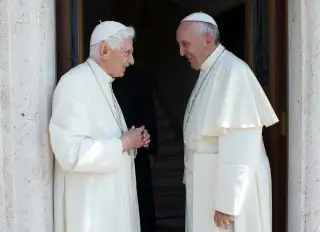The Pope's Retirement Package Is Better Than Yours

Talk about a golden parachute. When Pope Benedict XVI became the first pontiff to resign in more than 600 years back in 2013, there was no real precedent for the type of pension plan he should receive. Luckily for him, the Roman Catholic Church came up with a retirement package for the then-85-year-old that would have most people thanking heaven.
The pope emeritus, as he is now known, receives a monthly pension of 2,500 euros. That’s currently equivalent to around $2,800, though at the time of his retirement CNBC reported it was closer to $3,300 per month.
At the time of his retirement, that was essentially the same as the $3,350 maximum monthly amount Social Security could pay to retirees in 2013. This year the maximum benefit is $3,515, for those who wait until they’re 70 to claim, though very few people qualify for that.
Not that he’ll need to use his pension for many expenses. Benedict lives rent-free in the Mater Ecclesiae, a renovated former nunnery inside Vatican City that overlooks the Sistine Chapel, with his private secretary and "four consecrated lay virgins" who attend to household tasks. The residence features a garden, private chapel, and expanded library, and the Roman Catholic Church covers all of Benedict's living expenses.
The former pope is also still covered by the Vatican’s private health care policy, according to the Independent. Good thing, considering health care is one of the most daunting (and expensive) things retirees in the U.S. typically need to plan for. In fact, a 2009 retirement report from Georgetown University found that “many priests identify health and medical issues as the most important issue" facing their retirement.
Read Next: All Of The Crazy Ways People Are Cashing In On The Pope's Visit To The U.S.
All of this is a much better deal than Celestine V, the last pope to resign—back in December 1294—received. Motivated by "the desire for humility" and a simpler life, Celestine was pope for just over five months before formalizing the papal resignation process in order to abdicate his position. Unfortunately for him, the new Pope Boniface VIII was worried Celestine might threaten his rule, and Celestine was imprisoned by Boniface until his death.
As for activities, Emeritus Pope Benedict spends most of his days praying, reading, listening to music, corresponding with others, and watching the news, according to the Catholic News Service. He also plays the piano and, somewhat notoriously, spends a lot of time with his cats.
Benedict’s pension is the standard for bishops in the church—the pope is technically the Bishop of Rome—but, as the Independent noted, if the current pope, Francis, were to make Benedict a cardinal emeritus, his pension would double to 5,000 euros per month. And that can buy a lot of red shoes.